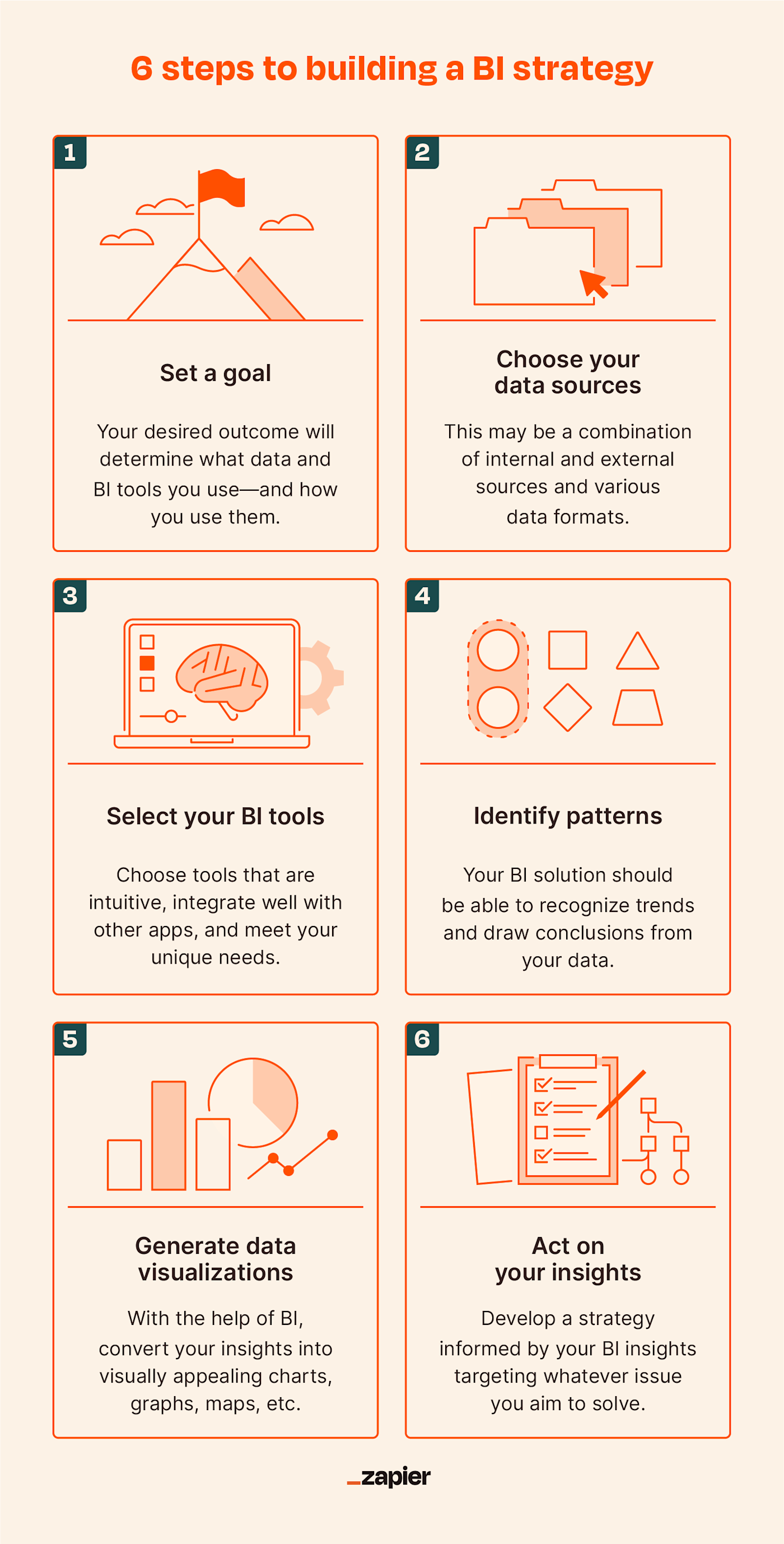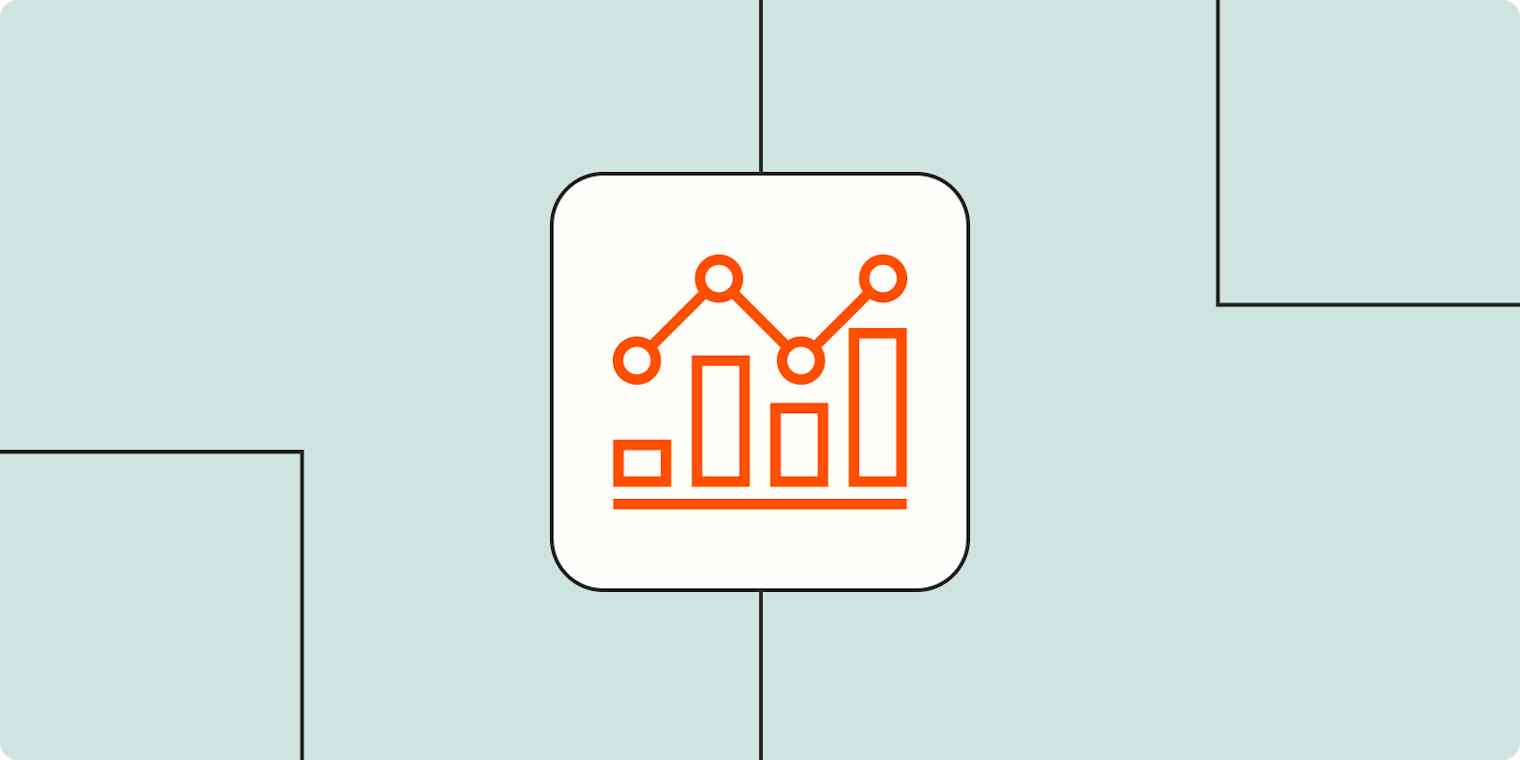Let's play a quick game of "would you rather." Would you rather manually sift through 6,000 rows of data in a spreadsheet to guide your next business strategy or have software do it for you?
If you prefer the former, you may be a data scientist (or a masochist). If you're anything like me, you cringe at the sight of uncategorized data and would much rather see an organized report or a series of data visualizations. Either way—we both need business intelligence.
So what is business intelligence, and how can you use it to make business decisions easier? In this guide, I unpack why you should implement a business intelligence strategy and what that may look like.
Table of contents:
What is business intelligence?
Business intelligence (BI) refers to the processes and tools used to collect, organize, and analyze data to determine how a business is doing and how it can improve from there.
Don't panic—BI doesn't mean your job as a business executive or data analyst is being taken over by robots. Organizing data into reports is only half the battle. Your job is to pull insights from that data and to make sound, human decisions. BI just automates the otherwise tedious process of data extraction and analysis, making your job a whole lot easier—and more effective.
How business intelligence works
Think of business intelligence as your company's data whisperer—it takes the loud cacophony of raw numbers and harmonizes them into a symphony of actionable insights. Just...a little less thrilling. Let's break down this not-at-all-magical but genuinely practical process:
Gather data: BI tools seek out data from various sources—your sales figures, customer feedback, market trends, and operational stats.
Integrate data: In this step, BI tools take center stage by seamlessly merging data from disparate sources into a unified system. They're adept at harmonizing information from various departments and IT systems, creating a comprehensive and cohesive view. This integration capability is crucial, as it ensures all relevant data is pooled together, allowing for a holistic analysis that reflects the full spectrum of the business's operations.
Manage data: Here, BI tools play a critical role in ensuring data quality and integrity. They automate the process of cleaning and sorting data, removing inaccuracies or duplications that can skew analysis results. These tools also implement robust security measures to safeguard sensitive information.
Analyze data: This is where data starts to tell its story. Through rigorous analysis, BI tools examine the intricacies and interactions within your data, identifying patterns, trends, and anomalies.
Visualize data: Visualization is about presenting the data in a format that is easy to understand, often as charts, graphs, or dashboards. This helps to communicate the data analysis findings clearly and effectively.
Take action: Whether it's pivoting your marketing strategy, streamlining your supply chain, or enhancing customer experiences, BI arms you with the intelligence to make informed moves that propel your business forward.
Business intelligence vs. data analytics
Data analytics and business intelligence are used together to develop strategic insights for businesses.
Data analytics uncovers what data means and what might happen next.
Business intelligence breaks results down into more concrete and actionable language.
Typically, data science professionals will interpret the results of business data analytics before BI makes the language less technical. Essentially, BI simplifies insights from data analytics to easier-to-parse business terms.
Think of it like the difference between a study conducted about a technical health topic and an article published about the study. The study's results may feel like a foreign language, but the article explains its implications and provides recommendations for readers to take home.
Here's another example:
As a digital marketer at an agency, I generate reports for my clients that summarize their performance using clear and actionable language. This part of my job parallels business intelligence.
To generate those reports, I first need to pull and analyze raw performance data. For example, I'll look at metrics like pageviews, bounce rates, CTR, and keyword movements as well as external factors that may play a role in their performance. This is where data analytics comes into play.
Benefits of business intelligence
Let's assume you aren't thrilled about the prospect of manual data analysis and interpreting results. Here are some reasons BI can make your systems work better.
Improved efficiency: It takes a lot longer to know what's going on in a spreadsheet than in a report filled with charts and graphs. BI converts the results of data analysis into data visualizations and other digestible formats that make it easier to make business strategy decisions. Plus, automating this step can save endless hours of sifting through data and minimize the chances of human error.
Improved decision-making: BI is data-driven, which helps to ensure you're making sound decisions. For example, business intelligence tools can generate dashboards and reports based on sales data that communicate what products are selling poorly and should either be discontinued or modified.
Improved employee impact: BI makes data analysis more accessible, freeing up time that IT teams and data analysts would have spent responding to user requests. With BI, employees are empowered to conduct their own analyses and pull insights from them.
Improved customer satisfaction: The last group to feel the effects of BI is arguably the most important: your customers and clients. Data-driven decisions make it far easier to meet your customers' needs.
How to build a business intelligence strategy

1. Set your goals for business intelligence
BI's uses are virtually unlimited. The first step to implementing it is deciding what business objective you want to accomplish. Do you want to compare the performance of your sales channels, use data from past marketing campaigns to inform your next one, or create a new HR dashboard with employee utilization data?
Example: A clothing company's goal may be to reduce the quantity of returns customers make.
2. Choose the datasets you'll need to solve your problem
For many uses of BI, you can rely entirely on trusted internal data, but some issues require external data. For example, you may want to take data published in a trade journal into consideration when implementing BI.
Example: That same clothing company may collect additional data from customers based on their buying patterns to identify what styles they like best and better market those styles to them.
3. Select the right tools to gather and organize it
Once you have all of your data sources collected, you're ready to choose the tools to transform, analyze, and learn from the data. The platform(s) you use will depend on your goals for BI, which is why determining those in Step 1 is vital.
Look for tools with the following functionalities to best accomplish your goals:
Automated data modeling and analytics
Ability to manipulate data to draw additional insights
Interactivity with data visualizations
Cross-team collaboration
Example: The clothing company may use a BI solution with powerful analytics capabilities to break down what customer data means about their interests and buying habits.
4. Uncover trends in your data
Leave it to the robots to identify patterns and create predictions from data. Most BI tools are built to execute descriptive and predictive analysis, which can shed light on where your business stands. For example, your BI platform might look at employee turnover history and make predictions about which departments need the most aggressive recruiting efforts and when.
Example: The clothing company's BI software may identify that customers are consistently returning a certain type of romper due to issues with fit, suggesting the company should reassess the item's design.
5. Generate data visualizations to present your findings
We've established that (almost) everyone prefers a colorful chart, graph, or map to a data-heavy spreadsheet. Data visualizations are especially useful when sharing findings with an entire team—they're easier to digest and are therefore better for motivating action toward a goal.
Example: The clothing company may use BI-generated charts to uncover how much profitability could increase by better targeting customers with personalized marketing efforts.
6. Act on your learnings
BI tools help show you where action can be taken, but they can't take action for you. Develop short- and long-term strategies based on your findings to tackle your problem areas, whether those be internal inefficiencies, supply/demand problems, or customer service shortcomings.
Example: The clothing company may initially phase out generally unpopular styles while collecting more customer data, then proceed to adjust its marketing strategy a few months down the line.
Business intelligence applications and examples
Consider using BI to help with the following:
Data mining: Data mining takes data from existing refined datasets and turns it into actionable information. For example, a company may use data mining to pull historical data on customer bounce rate. This could help the company identify which pages it should modify to better lead customers down the buyer funnel.
Visualizations: Maybe all of your data is organized and consolidated, but you have to present your findings to a large audience. Use BI to generate clear and aesthetically pleasing data visualizations. For example, a company executive might use BI to generate a series of charts illustrating their company's new strategy and present them at a conference.
Reporting: Another practical way to present data findings is through report generation. An agency may, for example, use BI to turn data from several successful case studies into a presentation for a prospective client who's skeptical about the agency's services.
Benchmarking: BI can pull and analyze data from competitors to help a business set benchmarks for its metrics. For example, if BI identifies that equally-sized competitors are averaging 15% more units sold per month, company leadership may tweak its benchmark to approach this number.
Online analytical processing (OLAP): OLAP is a powerful BI capability that allows for the swift analysis of data from multiple database systems at once. It's particularly useful for complex calculations, trend analysis over time, and data modeling. For instance, a financial analyst might use OLAP to perform a multidimensional analysis of financial data to identify spending trends across different departments.
Predictive analysis: Predictive analysis uses historical data, statistical algorithms, and machine learning to identify the likelihood of future outcomes. For example, a retail company could employ predictive analysis to forecast future sales, inventory needs, or customer buying behaviors, using these insights to make informed stocking and marketing decisions.
Operational intelligence: This form of BI provides real-time monitoring of business operations. An operational dashboard might display up-to-the-minute supply chain information, enabling logistics managers to immediately adjust delivery routes or schedules in response to unexpected delays.
Locational intelligence: Combining geographic data with traditional BI data to gain insights based on location, locational intelligence can be vital for businesses. A common application is in retail site selection, where a business may use locational intelligence to analyze a region's demographic and economic data to decide where to open new stores or how to optimize its supply chain.
How to choose a business intelligence solution

Apart from choosing a BI tool that meets your unique needs, be sure that whatever solution you choose includes the following qualities:
Ease of use: Minimize frustration by choosing a tool with a clear, easily navigable interface. Looker Studio, for example, keeps reports clean and organized and makes it easy to modify their look and feel.
Built-in AI: Many modern BI tools come with built-in artificial intelligence to aid in data analysis, offering predictive insights and automating the discovery of trends. Microsoft Power BI is perhaps the most prominent example of this integration, offering advanced analytics, natural language processing, and machine learning to turn data into actionable business intelligence.
Integration capabilities: Enhance your BI process with the help of integrations. With the help of Zapier, you can connect BI tools like Zoho Analytics with thousands of popular apps to make BI seamless.
Extensive data visualization options: Most BI solutions have data visualization capabilities, but not all are equal in this area. SAS Viya specializes in visualization, turning your data into captivating visual dashboards.
Here's a list of the best business intelligence software to get you started.
Once you've implemented business intelligence software, automate it with Zapier so you can spend time making your customers happy instead of frying your brain staring at spreadsheets.
Business Intelligence FAQ
Here are some quickfire FAQs, so you don't have to sift through 2,000-something words to find out whether or not you need to have a PhD in data science to use business intelligence effectively (you don't):
What is the main purpose of business intelligence?
The core objective of business intelligence is to convert data into actionable insights. By analyzing raw data, BI helps organizations make strategic decisions, identify opportunities for improvement, and gain a competitive edge.
How do I learn business intelligence?
You don't need a PhD to get into BI—start with some online courses that cover the basics, like data analysis and pattern recognition. Throw in a bit of practice with popular BI tools and maybe a few YouTube tutorials, and you'll be on your way. As you progress, don't overlook the power of a good BI community forum, where you can glean insights from those who have navigated this path for a long time.
To be clear: there are seasoned BI experts out there who have spent years refining their knowledge in this field. Their depth of understanding is something to aspire to, but it's not impossible to achieve.
Does business intelligence need coding?
Coding can be a plus when you want to go all mad scientist with your data, but it's not a must. Plenty of BI tools today are like Star Wars-themed LEGO sets—they let you piece together nifty data models without actually knowing the mechanics or science behind the Millennium Falcon. But dabbling in a bit of SQL or Python can definitely add some muscle to your BI game.
Related reading:






